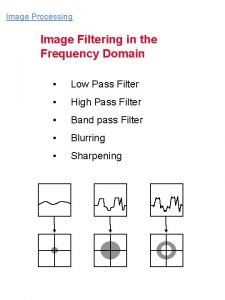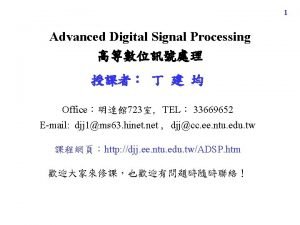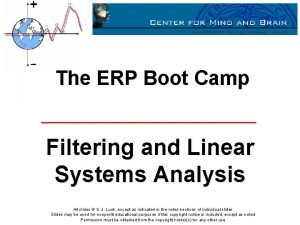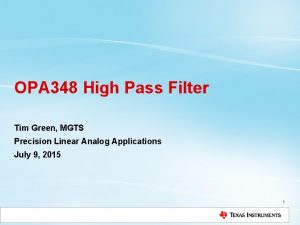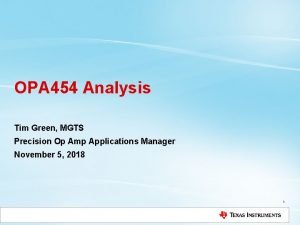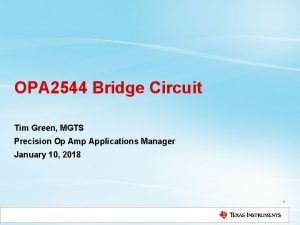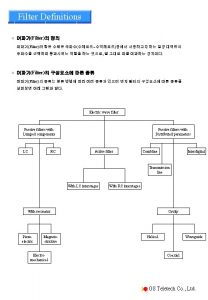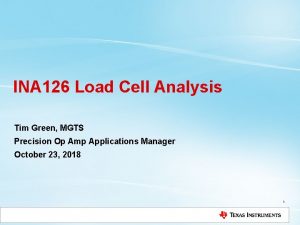OPA 348 High Pass Filter Tim Green MGTS











- Slides: 11

OPA 348 High Pass Filter Tim Green, MGTS Precision Linear Analog Applications July 9, 2015 1

Summary 1) See included schematic of your circuit. At 159 Hz you will find the Vout/Vin Transfer function measured out of Voa 2 is -6 d. B down at your high pass filter of 159 Hz. Correspondingly you can measure the gain at any frequency by using the free SPICE Simulator I reference at the end. At 400 Hz Voa 2/VG 1 = 38. 798613 d. B = x 87 (not x 100)! 2) I also provide mathematics for computing magnitude at any frequency. 3) Low pass roll-off is due to the closed loop gain of 10 intersecting op amp Aol. See TIPL link below for details: http: //www. ti. com/lsds/ti/amplifiers-linear/precision-amplifier-precision-labs. page? DCMP=tipl&HQS=hpa-pa-opamp-tipl-vanity-tr-en Look at the ones on Bandwidth. 4) You may or may not be able to connect your existing circuit directly your ADC input and get <1/2 LSB error each time you acquire a sample. Let me know which ADC you are using, ADC reference voltage, conversion and acquisition time. I can help guide you to get it right by design. 2

OPA 348 High Pass Filter 3

Bode Plot Gain and Phase Calculations Tim Green Precision Linear Analog Applications August 5, 2013 4

Typical Pole and Typical Zero 5

TINA Simulation Magnitude: Pole A: (400; -644. 622921 m) B: (4 k; -12. 30451) Zero A: (400; 644. 622918 m) B: (4 k; 12. 30451) Phase: Pole A: (400; -21. 801708) B: (4 k; -75. 963501) Zero A: (400; 21. 801708) B: (4 k; 75. 963501) AC Simulation run with 1000 points. Correlation with Calculation depends on number of points used for simulation 6

Simulation versus Calculated Results Magnitude: Pole A: (400; -644. 622921 m) B: (4 k; -12. 30451) Zero A: (400; 644. 622918 m) B: (4 k; 12. 30451) Phase: Pole A: (400; -21. 801708) B: (4 k; -75. 963501) Zero A: (400; 21. 801708) B: (4 k; 75. 963501) 7

Formulae for Pole and Zero Calculations 8

Closed Loop Gain: Magnitude and Phase 9

Closed Loop Gain: Magnitude and Phase: 2 Pole, 2 Zero Calculator 10

Op Amp Stability Reference For detailed, definition-by-example of 10 different ways to stabilize op amps driving capacitive loads, and additional technical information on solving op amp stability problems, visit the Texas Instruments E 2 E Forum at: http: //e 2 e. ti. com/support/amplifiers/precision_amplifiers/w/design_notes/ 2645. solving-op-amp-stability-issues. aspx Download Part 1, Part 2, Part 3, and Part 4. All Embedded Schematics in this presentation can be run in the Free TINA_TI SPICE simulator available at: http: //www. ti. com/tool/tina-ti 11
 Frequency domain image
Frequency domain image High pass filter matlab
High pass filter matlab 高等數位訊號處理 丁建均
高等數位訊號處理 丁建均 Rangkaian lpf
Rangkaian lpf Time frequency domain
Time frequency domain Lpf hpf
Lpf hpf Green green green red
Green green green red Perbedaan rapid sand filter dan slow sand filter
Perbedaan rapid sand filter dan slow sand filter Blt method will convert analog filter to dt filter that has
Blt method will convert analog filter to dt filter that has Difference between rapid sand filter and slow sand filter
Difference between rapid sand filter and slow sand filter Round off to the nearest hundred thousand
Round off to the nearest hundred thousand Ten thousand in numbers
Ten thousand in numbers
